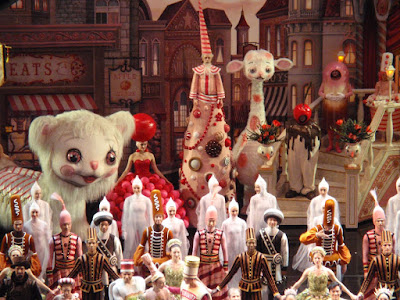Ballet Review: A Richard Strauss Pastry Extravaganza Delights at ABT
Whipped Cream
(Schlagobers)
Music by Richard Strauss
Choreography by Alexei Ratmansky
American Ballet Theater
Metropolitan Opera House, Manhattan
July 6, 2018
Who knew that Richard Strauss, he of the long, philosophically-wrought
operas and tone poems like Also Sprach Zarathustra
and Die Frau ohne Schatten, also
wrote fun ballet scores? Not me. So imagine my delight to see and hear the
delightful Whipped Cream, one of the
latest of choreographer Alexei Ratmansky’s American Ballet Theater archival
revivals. The original premiered in Vienna in 1924, during a time of post-WWI
hardship, so its extravagance caused it to be derided as “the billionaire’s
ballet” and it quickly vanished from the scene only reappearing last year in
Los Angeles with the new ABT production. I suspect Strauss had a noble intent, much like the escapist Ziegfield
Follies musicals of the depression 1930s. He wrote, “I cannot bear the tragedy
of the present time. I want to create joy.” That he did!
The slight plot is a
Viennese The Nutcracker-- a mix of whimsy, peculiar humor, and romance. A boy
gorges on too much whipped cream and falls ill. As he is removed from the
pastry shop, the various ingredients (coffee, praline, whipped cream) come to
life and dance. At the hospital, mean doctors and nurses try to inject him with
drugs, but dancing alcoholic beverages tempt the medical practitioners who,
impaired, fall into a stupor and allow the boy to escape from the hospital room
into his pastry fantasies. Unlike The Nutcracker,
the boy seems totally innocent and does not have subliminal sexual longings for
the tempting female sweets parading by. The music sounds most like Strauss’ Viennese
opera Der Rosenkavalier from 13 years
earlier, but has its own character and delicacy. It liberally uses ethnic dance
episodes (coffee, tea) rather like the Tchaikovsky ballet. The orchestration is
colorful, and the ending sequence features a lovely melody for the strings
soaring above the orchestra, typical of Strauss’ operas. It is a shame that an
episode of dancing Jewish matzo balls parading with socialist flyers was cut
back at the premiere, apparently criticized as anti-Semitic (Really? Anti-Semitism
criticized in 1920’s Vienna? Really?). That episode gives you a sense of the whimsy
of Strauss’ concept.
The Ratmansky/ABT production was gloriously decadent,
bright, and colorful. The stage filled with colorful human and superhuman pastry
concoctions, rather like those Carmen Miranda dancing banana spectaculars of
the 1940s.
The grownups had huge, scary heads, and the dancing nurses had enormous
scary syringes.
Ratmansky’s choreography was a mix of classical steps, parody,
and a bit of Viennese waltz, just right for the score. There was a nice mix of
distinctive solos and equally distinctive corps
dances. I particularly loved the entrance of the dancing whipped cream corps de
ballet, dressed in fleecy white. Their one-at-a-time
entry down an upstage slide was a witty evocation of both the famed Kingdom of the Shades entrance in La Bayadère and a 1930s Busby Berkeley water ballet.
The analogy to La Bayadère
is apt, as much of Whipped Cream
seems to exist in an either sugar- or drug-induced hallucinatory state of the
young boy, much like the opium-induced Shades entrance dreamed by Solor. The
dancing was excellent, especially The Boy of Jeffrey Cirio: virtuosic, spinning,
and leaping around the stage, and appropriately juvenile in mannerisms. Much of
the restless young audience seemed to be there to see new ballerina-of-color
heroine Misty Copeland, who made the usual medium-grade impression on me,
without having very much special to say in her role as Princess Praline. Both
ABT and Ratmansky should be thanked for this and Harlequinade, both which left me with big smiles and appreciation
for a fusion of movement and music that is dance at its best. Another plus:
this is a huge attendance boost for ABT, rather like a summertime Nutcracker to draw families. Its always
nice to create a box office bonanza in these days of declining arts attendance.




Comments
Post a Comment